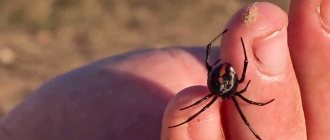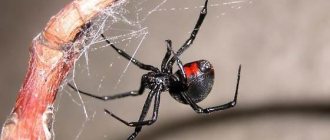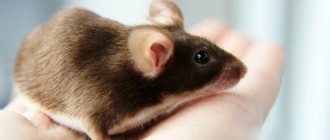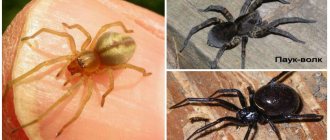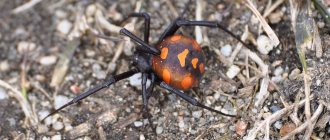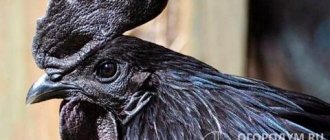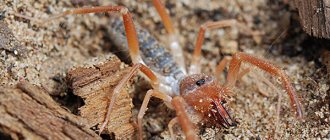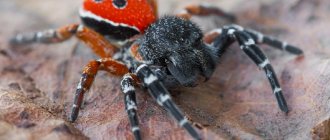- Wild animals
- >>
- Arachnids
The prevalence of sexual cannibalism, in which the female eats the male after mating, influenced the species' common name, black widow . This species is considered to be one of the most poisonous. The venom of a female spider exceeds the toxicity of toxic substances in a rattlesnake. However, only a female bite is dangerous to humans. The bites of male and teenage spiders are harmless.
Origin of the species and description
Photo: Black Widow
The black widow genus was classified by Charles Athanas Walkenaer in 1805. Arachnologist Herbert Walter Lewy revised the genus in 1959, studying the female genitalia and noting their similarities between described species. He concluded that color variations were variable throughout the world and were not sufficient to warrant species status, and reclassified the red and several other species as a subspecies of the black widow spider.
Video: Black widow spider
Levy also noted that the study of the genus had been extremely controversial before this, as in 1902 F. Pickard-Cambridge and Friedrich Dahl revised the genus, each criticizing the other. Cambridge questioned the division of the Dahlem species. He considered the deviations that his opponent drew attention to as minor anatomical details.
This is interesting! In the 1600s, people in southern Europe danced and raved after being bitten by a variant of the Black Widow. The movements were said to relieve painful symptoms. Their rhythmic movements were later called the tarantella dance, after the Italian region of Taranto.
Many people don't like spiders. Some believe they bring bad luck; others, on the contrary, believe that they bring good luck. Black widows have been useful in controlling pests such as fire ants and termites. Previously, doctors often made the wrong diagnosis after a spider bite. Mistaking the severe condition of the chest and abdomen for symptoms of a perforated appendix.
Black widows attack Russia. Video (00:03:13)
To combat karakurts, arachnologists - spider experts - recommend treating your garden plot with chemicals. It is noteworthy that the black widow does not attack people herself. She can bite if, for example, you step on her. The karakurt poison spreads throughout the body instantly. If you do not go to the hospital in time, death occurs within two days. At the moment of the bite, the victim does not feel pain; it occurs only after 10-15 minutes. Sharp pain appears in the lower back, abdomen, chest, breathing is impaired, and convulsions occur. With timely treatment, recovery occurs in 2-3 weeks. Karakurt is a fairly large spider, reaching 2 centimeters in length. The spider is black in color and has 13 red spots on its back. It is considered the most dangerous spider in Russia. Karakurts are rapidly spreading across dozens of regions of the country. The Volgograd region is now experiencing a real invasion. There are traditionally a lot of them in Crimea. Cases of bites have been recorded in the Urals, Saratov, Orenburg and Novosibirsk regions. According to experts, with such dynamics, the Moscow region is next in line. The rapid advance of the karakurt deep into Russia is alarming; the scale of the danger is impressive: the “kiss” of a black widow is 15 times more poisonous than the bite of a rattlesnake. In several regions of Russia, almost 20 people have suffered from poisonous spiders, six are in intensive care. The poisonous spider has been spotted not only in the south of the country, but also in Novosibirsk and Moscow, where the karakurt (the official name of the insect) is driven by the heat from its traditional habitats - the Central Asian steppes. By the way, they tried to settle in the Moscow region a couple of years ago. Fortunately, it hasn't worked out yet.
Appearance and features
Photo: Black widow spider
The black widow (Latrodectus) is a widespread genus of spider, a member of the family Theridiidae. The name Latrodectus is believed to mean "secret bite" in Greek. The genus contains 31 species, including North American black widows (L. hesperus, L. mactans and L. variolus), European black widow (L. tredecimguttatus), Australian red-and-black widow (L. hasseltii) and South African button spiders. Species vary greatly in size.
Female widow spiders are usually dark brown or shiny black. Adults have red or orange hourglasses on the ventral surface (underside) of the abdomen. Some species have only a couple of red spots or no markings at all.
Male black widow spiders often have various red, yellow, or white markings on the dorsal surface (upper side) of their abdomen. The females of several species are pale brown, and some have no bright spots. They are larger than males. The bodies of spiders range in size from 3 to 10 mm. Some females can be 13 mm long.
The legs of the widow spider are quite long, relative to the body, and resemble a “comb” with a row of curved, elastic bristles on the hind limbs. Throwing the web at prey is done with the rear comb.
On a note! These small spiders have an unusually powerful venom containing the neurotoxin latrotoxin, which causes the condition of latrodectism.
Female widow spiders have unusually large venom glands, and their bite can be especially harmful to large vertebrates, including humans. Despite their notoriety, Latrodectus bites are rarely fatal or even cause serious complications.
What does a karakurt spider look like?
The arthropod belongs to the family of web spiders, the genus of black widows and the species of karakurt. These spiders have lived on the planet for more than 300 million years, and during this time their appearance has remained virtually unchanged, although they used to have a rather long tail, which they no longer have.
Karakurts exhibit strong sexual dimorphism, that is, females are noticeably different from males. They are larger, their size is up to 2 cm, while males are less than 1 cm. Their body and limbs are black, there are red spots on the belly, which may have a not too bright white edge. The spots on the abdomen disappear when the spider reaches sexual maturity, when it becomes completely black.
The karakurt has 4 pairs of paws, with the first and last pairs being long and the middle pairs being short. There are hairs on the legs, thanks to which the karakurt spider does not stick to the web and moves freely along it.
Karakurt black widows are prolific. Every 9 to 12 years there is an outbreak of fertility and a real invasion of spiders. This happened in 2022. The increase in population is often associated with an increase in the number of locusts. This is one of the main types of food for black widows. That is, as the amount of food increases, more spiders survive.
The mating season of these arthropods occurs in the summer. At this time, spider venom becomes especially toxic. After mating, the female usually eats the male and then lays eggs. Even if she does not eat him, the male will die in any case, since he stops feeding immediately after reaching maturity. The female lays eggs in cocoons and then dies. One female karakurt lays from five to twelve cocoons with eggs, in each cocoon from a couple of hundred to two thousand eggs, sometimes there are even more. Spiders are born in cocoons and remain in them until spring, until the weather warms up. At first they have enough nutrients that are in the cocoon, but then, when there is not enough food, they kill and eat each other. By spring, the strongest survive in the cocoon, and they emerge into the light.
Karakurts are born almost transparent, after the first molt they darken noticeably and acquire three rows of light spots on the abdomen. With the next molt, the body becomes darker and the spots turn red. In total, during the maturation period, the spider goes through from six to nine moults, their number and frequency depend on the amount of available food. Females develop faster and more actively. After molting and reaching sexual maturity, males stop feeding with the same activity and go in search of females.
Where does the black widow spider live?
Photo: Black widow animal
The species can be found on all continents of the world except Antarctica. In North America, black widows are commonly known as southern (Latrodectus mactans), western (Latrodectus hesperus) and northern (Latrodectus variolus). They can be found in all four deserts of the American Southwest, as well as parts of southern Canada, especially the Okanagan Valley of British Columbia. In addition, “gray” or “brown widow spiders” (ometricus) and “red widow spiders” (bishopi) are found on the American continent.
The area of residence is distributed as follows:
- American continent - 13 varieties;
- Eurasia - 8;
- Africa - 8;
- Australia / Oceania - 3 species;
- One species (geometricus) - lives everywhere except Eurasia;
- The most common species, found in East Asia and Australia, is commonly called the redback (Latrodectus hasselti). Hundreds of Australians are bitten every year by the red spider, a relative of the black widow. It is found in all parts of Australia except the hottest deserts and the coldest mountains.
Interesting fact! Black widows prefer to nest near the ground in dark and undisturbed areas, usually in small holes created by animals, around construction openings or wooden piles on the underside of ledges, rocks, plants and debris. Only cold weather or drought can drive these spiders into buildings.
The brown widow spider (Latrodectus geometryus) is not as dangerous as black spiders. When it bites, it releases less venom. However, it is a poisonous creature and should be handled with caution. It is found in all tropical regions of the world and has been introduced to southern Texas, central and southern Florida, and is now also found in southern California.
The most poisonous spiders in the world TOP 10. Video (00:04:00)
Rating: The deadliest spiders in the world The most poisonous spider in the world, according to the Guinness Book of Records, is the “Brazilian wandering spider.” The spider got its name because it does not sit in one place and does not weave webs, but actively moves in search of food. Another extremely dangerous spider is the Black Widow, or in our language Karakurt, which can be found in the Caucasus and Crimea. I present to your attention the rating of the 10 most poisonous and dangerous spiders on planet Earth 10. Yellow spider Sak (Cheiracanthium Punctorium) 9. Fringed Ornamental Tarantula 8. Chinese tarantula Chinese Bird Spider 7. Mouse Spider 6. Brown or Chilean spider recluse Brown and Chilean Recluse Spider 5. Redback spider 4. Black widow (Karakurt) 3. Sydney funnel-web spider 2. Six-eyed sand spider. 1. Brazilian wandering spider
What does the black widow spider eat?
Photo: Poisonous black widow
Like most arachnids, the black widow preys on insects. Sometimes she eats mice, lizards and snakes caught in nets, but very rarely. In deserts, black widows live on a diet of scorpions. It is known that its web is the strongest compared to other types of spiders. Widows do not weave pretty webs, but instead create an elastic weave of thick threads that is rough and sticky.
Interesting fact! The tensile strength of Black Widow's web was found to be comparable to that of steel wire of the same thickness. However, since the density of steel is about six times that of spider web, the resulting web is stronger than steel wire of the same weight.
To catch prey, black widows create a “tangle” of three levels:
- Supporting threads on top;
- Ball weaves of threads in the middle;
- Attached to the ground are vertical trap threads at the bottom with sticky drops.
The spider often hangs upside down near the center of its web and waits for insects to make a mistake and get caught in the web. Then, before the victim can escape, the widow rushes towards her to inject her with poison and wrap her in silk. Her mouth pulses with digestive juices over her prey, which gradually liquefies. The black widow then makes small punctures in the victim's body and sucks on the suspension, allowing it to be sucked back into the mouth.
Prey caught in the net includes various small insects:
- cockroaches;
- beetles;
- flies;
- mosquitoes;
- grasshoppers;
- caterpillars;
- moths;
- other spiders.
Like all spiders, black widows have very poor eyesight and rely on vibrations in the web to locate trapped prey or alert them to danger.
What kind of life does a karakurt lead?
Most often, the karakurt makes a nest at the base of grass stems or directly on the ground, where it weaves spherical cocoons for eggs and places a trapping net nearby. Catching nets and cocoons are made of very strong, tightly stretched web with a stretch coefficient of up to 30%.
Karakurt builds cocoons in July - August. After 5-7 days, spiderlings appear in the cocoon, but they emerge from there only next year at an air temperature of 30° (15-20° degrees in the shade).
Karakurts are not aggressive towards humans; when they meet, they leave or pretend to be dead. A spider can bite at the moment when the trapping nets are disturbed, or it is pressed against the human body. This most often occurs when spending the night in natural conditions, much less often during the day when collecting wildflowers, hay or straw, or lying on the ground.
The toxicity of karakurt venom depends on many factors: season, age and gender of the spider. Mature females are especially poisonous in comparison with young ones, in which red dots on their black abdomen are surrounded by a white border.
Features of character and lifestyle
Photo: Black widow spider
The black widow spider is nocturnal. She hides in dark and untouched places, in small recesses created by animals, under fallen branches, piles of trees and rocks. Sometimes they live in rodent burrows and hollow stumps. Other habitats include garages, outbuildings, and sheds. Nests inside homes are found in dark, undisturbed places such as tables, furniture, and the basement.
Sexual cannibalism in the female actually increases the chances of survival of the offspring. However, females of some species rarely exhibit this behavior. Much of the documented evidence of sexual cannibalism occurs in laboratory cages where males cannot escape.
This is interesting! Male black widow spiders choose their mates by determining whether the female is currently full to avoid being eaten. They can tell if a spider has eaten by looking at sensitive chemicals in the web.
The widow is not aggressive, but can bite when her calm is disturbed. If caught in a trap, it is unlikely to bite, preferring to play dead or hide. Bites are possible when the spider is cornered and cannot escape. Injuries to humans occur due to defensive bites caused when a female is unintentionally crushed or pinched.
Need to know! Black widow venom is poisonous. When the fangs enter the skin, they remain there for a few seconds. Venom glands contract to deliver venom through ducts in the fangs.
The syndrome resulting from the bite is known as "latrodectism." Painful symptoms are felt throughout the body. Black widow venom is called "neurotoxic" because it affects the nerves. When the nerve endings do not work: the muscles cease to obey, the body becomes rigid, paralysis and convulsions intensify. Sometimes the breathing muscles stop working, causing suffocation.
Social structure and reproduction
Photo: Black Widow
Black widows usually mate in the spring and summer. The female produces an egg mass containing about 200+ eggs. She covers the eggs with cobwebs, then forms a pouch from this, which should protect the eggs from external influences. The sac is suspended from a web to keep it away from predators.
It takes about two weeks for the eggs to hatch. Very few young spiders survive because they eat each other as soon as they are born. Spiderlings molt several times before reaching maturity. Diet and temperature are factors that influence the development of the offspring.
Remember! Females take 2 to 4 months to mature and their lifespan is about 1.1/2 years. Males mature in 2-4 months and live for about 4 months. They lose their outer covering (exoskeleton) as they grow.
Sexual contacts between mating spiders last longer if the male allows himself to be cannibalized. By sacrificing his life, he can fill his partner with more sperm. The female stores these sperm in two storage organs and can control when she uses these stored cells to fertilize her eggs.
If she has sexual intercourse again, the sperm of the second male may displace the sperm of the first. But females who eat their first mate are more likely to reject a subsequent one.
Lifestyle
Spiders live alone. They gather in pairs only for mating. After fertilization, the female lays up to 900 eggs at a time. Envelops them in a web, forms a cocoon, and drags them along. In 4 weeks, spiders are formed inside, which are also cannibals. In the cocoon they feed on each other, and the strongest are born. A maximum of 10 cubs remain alive. For some time the young generation sticks to their mother, then scatters in different directions.
The black widow feeds mainly on insects, beetles, larvae, and weaker spiders. Snakes, snakes, frogs, lizards, and rodents often get caught in the web. The predator paralyzes them with poison, injects saliva, which liquefies the insides, then calmly drinks it.
On a note!
Spiders similar to the black widow lead a similar lifestyle, but differ in less toxic poison. The most similar are karakurts. Many species are found in Russia. They are often called false widows.
Natural enemies of the black widow spider
Photo: Animal black widow
These spiders, although a little scary, also have enemies. Several types of wasps can sting and paralyze a spider before eating it. Black widow is also the praying mantis' favorite food. Some birds may eat these spiders, but will end up with an upset stomach.
Bright red or orange markings on the belly area warn predators that this is a nasty meal. Most vertebrates that hunt visually detect this red-black signal and avoid using it.
Among spiders, brown widows usually replace black ones quite quickly in their habitats, although it is not known for sure whether this is a sign of predation, or perhaps they are simply driving them away in some other way. Some varieties of cellar spiders also feed enthusiastically on black widows.
Other arthropods can eat black widows, but they must be able to grab the spider before it bites them, which they rarely do.
This is a very fast spider, it is able to detect in advance small vibrations produced by a predator. If he is in danger, he descends to the ground along the web and hides in a safe place. The spider often pretends to be dead to deceive a potential enemy.
The blue mud wasp (Chalybion californicum) in the western United States is the black widow's primary predator. Alligator lizards can also sometimes “feast” on such extravagant food.
Black widow bite
Symptoms of a bite include the presence of two small punctures, headache, acute pain in the affected area, severe burning, nausea, vomiting, and weakness.
Male black widow.
First aid consists of:
- immobilizing the victim;
- applying a cold compress or ice;
- washing the wound with soap;
- immediately go to the hospital.
Doctors use an IV containing calcium gluconate and muscle relaxants. In the most difficult cases, a special serum is needed. Its administration is strictly controlled by a doctor and is not recommended for adolescents under 16 years of age. Surprisingly, the blood of the spider itself is the best antidote.
